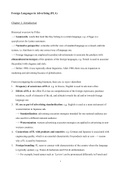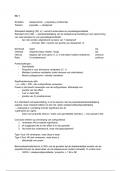Chapter 1: Introduction
Historical overview by Piller:
—> Loanwords: words that look like they belong to a certain language, e.g. el Eggo is a
spanification for Latino customers.
—> Normative perspective: coincides with the view of standard language as a closed, uniform
system, i.e. that there is only one correct way of language use.
—> Foreign languages are employed in product advertisements to associate the products with
ethnocultural stereotypes of the speakers of the foreign languages, e.g. French is used to associate
the product with elegance and style.
—> Before 1980, it was especially about linguistics. After 1980, there was an expansion to
marketing and advertising because of globalization.
From investigating the existing literature, there are six topics identified:
1. Frequency of occurrence of FLA: e.g. in Greece, English is used in ads more often.
2. Effects of FLA: the effect FLA has on comprehension of the foreign expression, purchase
intention, recall of elements of the ad, and attitude towards the ad and/or towards foreign
language use.
3. FL use as part of advertising standardization: e.g. English is used as a main instrument of
westernization in Japanese ads.
—> Standardization: advertising execution strategies intended for one national audience are
also used for a different national audience.
—> Westernization: western advertising execution strategies are applied in advertising in non-
western countries.
4. Connections of FL with products and countries: e.g. German and Japanese is associated with
engineering quality, which is an essential characteristic for products such as cars —> reason
why a FL is used by businesses.
5. Foreign branding: FL seem to connect with characteristics of the country where the language
is typically spoken; e.g. France & hedonism and USA & utilitarianism.
—> For example, brand names such as ‘Larient’ can be pronounced differently in French and
1
, in English, and this has an effect on the perception of the brand name; it was found that the
French name lead to better evaluations when they promote hedonistic products (e.g. nail
polish) rather than utilitarian products (e.g. petrol).
6. English versus Spanish for US hispanics: e.g. the hispanics perceived the advertiser to be
more culturally sensitive when the advertisers used (some) Spanish than when they used only
English (could be the same effect for when Frisian is used in a Dutch ad).
Conclusion: there is an academic interest in foreign languages in advertising, both in the business
domain and the linguistics domain. However, there is a lack of integration of insights from one
field to the other.
—> The first two studies that investigated this combination is by Snyder et al. and Mueller; they
studied the national character (restriction to local language), the use of foreign languages, and the
standardized/global view through the use of English.
—> Alden et al. presents a framework that captures all these three functions of foreign languages in
advertising and goals with which various languages can be used in advertising.
The study of Alden et al. presented 3 different types of brand positioning strategies in advertising in
the light of globalization and internationalization.
—> Brand positioning: ensuring that a brand has a unique position among its competitor brands
for the customer. This depends on a number of variabels, including language choice.
The 3 different types of brand positioning:
—> Global Consumer Culture Positioning (GCCP): ‘identifies the brand as a symbol of a given
global culture, featuring the idea that consumers all over the world consume a particular brand or
appealing to certain human universals might invest the brand with the cultural meaning of being a
conduit to feeling at one with global culture.’ (e.g. use of English in FLA).
—> Local Consumer Culture Positioning (LCCP): ‘a strategy that associates the brand with local
cultural meanings, reflects the local culture’s norms and identities, is portrayed as consumed by
local people in the national culture, and/or is depicted as locally produced for local people.’
—> Foreign Consumer Culture Positioning (FCCP): ‘a strategy that positions the brand as
symbolic of a specific foreign consumer culture; that is, a brand whose personality, use occasion,
and/or user group are associated with a foreign culture.’
2












